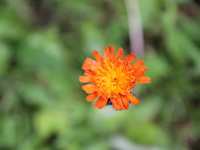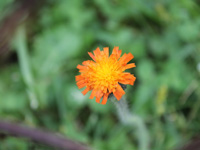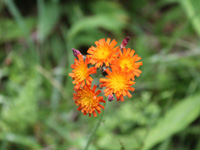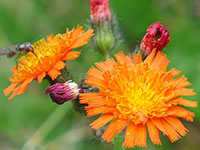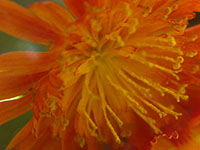![]()
Orange Hawkweed is a flowering plant of the Aster family native to alpine regions of central and southern Europe, where it is protected in several regions. Orange Hawkweed is widely grown as an ornamental plant in gardens for its very decorative flowers. It has been introduced into Australasia and North America and escaped from gardens and is considered an invasive species in some areas. It is found across Canada and the north of the U.S., reaching more in the south on the coasts. The plant is easily removed, until it seeds back, by plowing or salting, and it cannot be controlled by mowing because it regularly reproduces vegetatively. It is on the noxious weeds and/or quarantine lists of Colorado, Idaho, Montana, Oregon, Washington, and regions of British Columbia, with cultivation usually prohibited. In Alberta, it is not considered a noxious weed except locally. In Australia, the plant is considered a noxious weed in Tasmania and it is quarantined from the country. It has been recorded at Kosciuszko National Park in New South Wales, Falls Creek and Mount Buller in Victoria and Fern Tree and Snug in Tasmania. In New Zealand, the plant is closely watched and attempts at control are made.
![]()
There is currently no commercial applications for orange hawkweed.
![]() Within the realm of rational and holistic medicine, there is currently no known uses for orange hawkweed.
Within the realm of rational and holistic medicine, there is currently no known uses for orange hawkweed.
Please note that MIROFOSS does not suggest in any way that plants should be used in place of proper medical and psychological care. This information is provided here as a reference only.
![]()
There currently is no information on the edibility of orange hawkweed.
Please note that MIROFOSS can not take any responsibility for any adverse effects from the consumption of plant species which are found in the wild. This information is provided here as a reference only.
![]()
Orange Hawkweed is suitable for light (sandy), medium (loamy) and heavy (clay) soils, and prefers well-drained soil. Orange Hawkweed can grow in nutritionally poor soil and is suitable for acidic and neutral soils. It can grow in semi-shade (light woodland) or no shade. It prefers moist soil.
| Soil Conditions | |
| Soil Moisture | |
| Sunlight | |
| Notes: |
![]()
Orange Hawkweed is a is a low-growing plant with shallow fibrous roots and a basal rosette of elliptical to lanceolate leaves 5cm to 20cm long and 1cm to 3cm wide. The flowering stem is usually leafless or with just one or two small leaves. The stem and leaves are covered with short stiff hairs (trichomes), usually blackish in colour. The stems may reach a height of 60cm and have 2–25 capitula (flower heads), each 10mm to 25mm in diameter, bundled together at the end of short pedicels. All parts of the plant exude a milky juice. The flowers themselves come in a range of colours from a deep rust-orange to a pure yellow and often show striking gradients of colour. The flowers are hermaphrodite (have both male and female organs) and are pollinated by Apomictic. The plant is self-fertile. The plants propagates through its wind-dispersed seeds, and also vegetatively by stolons and shallow rhizomes.
![]()
| Plant Height | 30cm to 60cm | 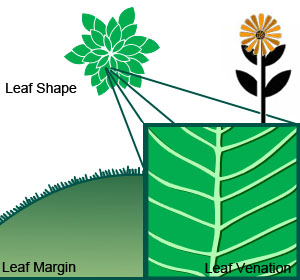 |
| Habitat | Fields, Roadsides, Clearings | |
| Leaves | 5cm to 12cm long, lanceolate rosette | |
| Leaf Margin | Ciliate | |
| Leaf Venation | Pinnate | |
| Stems | Hairy Stems | |
| Flowering Season | June to August | |
| Flower Type | Medium sized ray flowers | |
| Flower Colour | Orange with Yellow centres | |
| Pollination | Apomictic | |
| Flower Gender | Flowers are hermaphrodite and the plants are self-fertile | |
| Fruit | Small tufted seeds | |
| USDA Zone | 4A (-31°C to -34°C) cold weather limit |
![]()
The following health hazards should be noted when handling or choosing a location to orange hawkweed:
 |
INVASION ALERT |
![]()
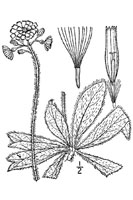 |
-Click here- or on the thumbnail image to see an artist rendering, from The United States Department of Agriculture, of orange hawkweed. (This image will open in a new browser tab) |
![]()
 |
-Click here- or on the thumbnail image to see a magnified view, from The United States Department of Agriculture, of the seeds created by orange hawkweed for propagation. (This image will open in a new browser tab) |
![]()
Orange Hawkweed can be referenced in certain current and historical texts under the following five names:
Orange Hawkweed can be translated into the following select languages:
| Arabic | Bulgarian | Chinese (Sim) | |||
| Croatian | Czech | jestřábník | Danish | ||
| Dutch | Esperanto | Estonian | |||
| Finnish | French | épervière | German | Habichtskraut | |
| Greek | Χιεράτσιο | Hebrew | ההירציונים | Hungarian | |
| Italian | Japanese | Korean | |||
| Low Saxon | Lithuanian | vanagių | Norwegian | ||
| Persian | Polish | Portuguese | |||
| Romanian | Russian | ястребинка | Slovak | jastrabník | |
| Spanish | Swedish | Tagalog | |||
| Turkish | Ukrainian | Нечуйвітер | Vietnamese |

![]()
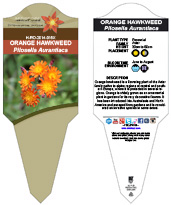 |
The MIROFOSS database offers free printable garden tags for personal and non-profit use. These tags can be used to properly identify plant samples in a garden. Click on the tags shown on the the screen or -click here- to download a full size jpeg image for an orange hawkweed identification tag; which can be printed on paper or used with a plastic laser printer. |
 |
What's this? What can I do with it? |
![]()
| Description | Peterson, Roger Tory; McKenny, Margaret (1968). A Field Guide to Wildflowers of Northeastern and North-Central North America. Houghton Mifflin Company Boston. ISBN 0-395-18325-1. |
| Description | Field Guide to Noxious and Other Selected Weeds of British Columbia (2002). "Orange Hawkweed (Hieracium aurantiacum)" |
| Folklore | Edsall, Marion (2007-12-15) [1985]. Roadside Plants and Flowers A Traveler's Guide to the Midwest and Great Lakes Area. |
| Biology | Dickinson, R.; Royer, F.; (2014) Plants of Southern Ontario. ISBN 978-1-55105-906-8. |
| Image Rendering | USDA-NRCS PLANTS Database / USDA NRCS. Wetland flora: Field office illustrated guide to plant species. USDA Natural Resources Conservation Service. |
| Environment | National Audubon Society. Field Guide To Wildflowers (Eastern Region): Alfred A. Knopf. ISBN 0-375-40232-2 |
| Physical Identification | National Audubon Society. Field Guide To Wildflowers (Eastern Region): Alfred A. Knopf. ISBN 0-375-40232-2 |
| May 29, 2015 | The last time this page was updated |
| ©2025 MIROFOSS™ Foundation | |
 |
|

